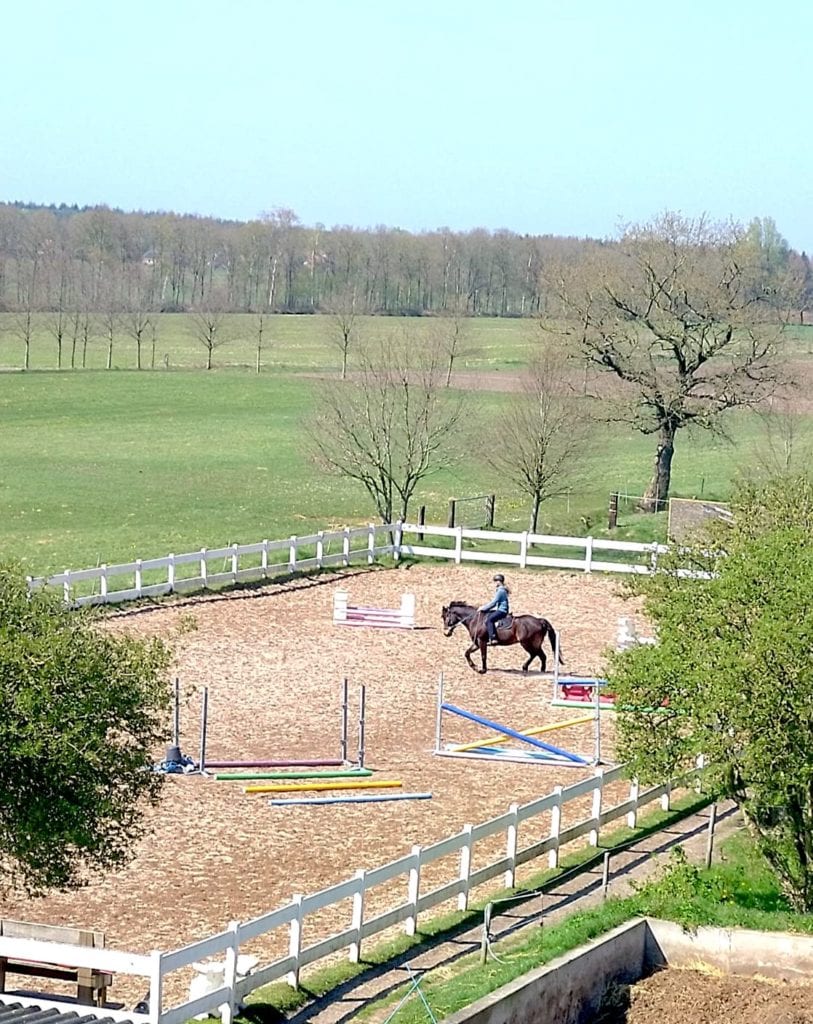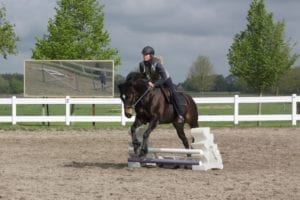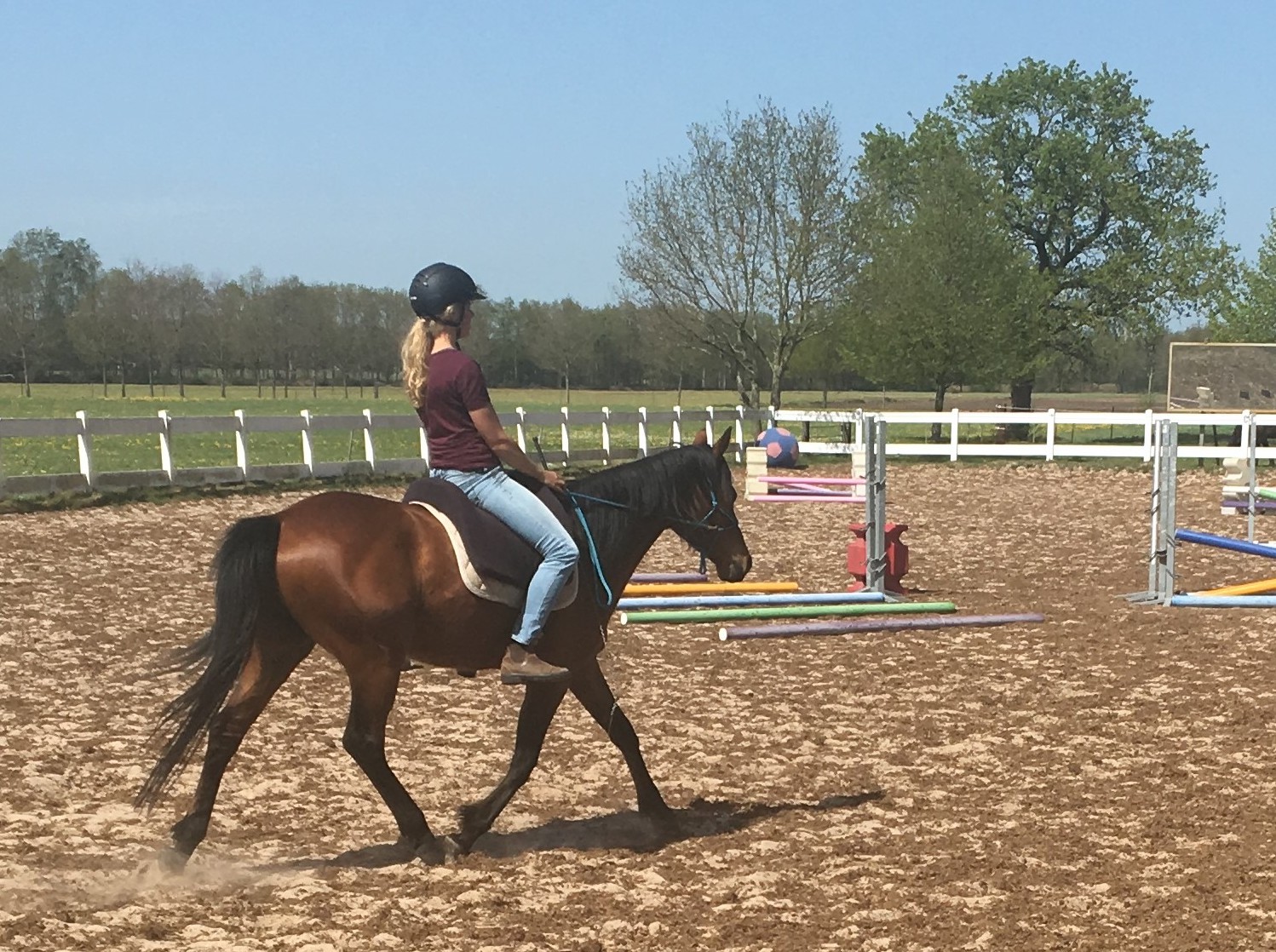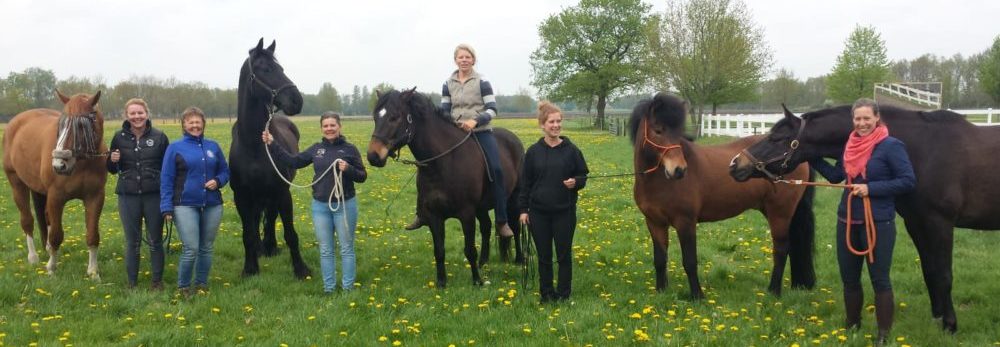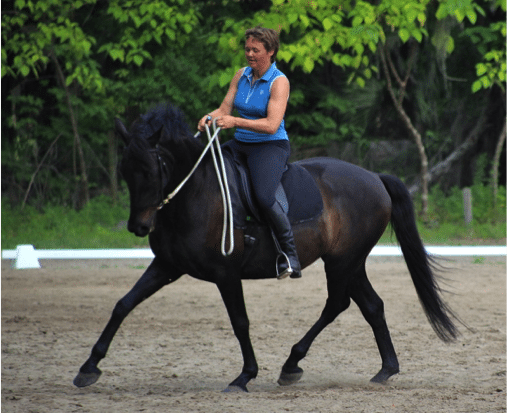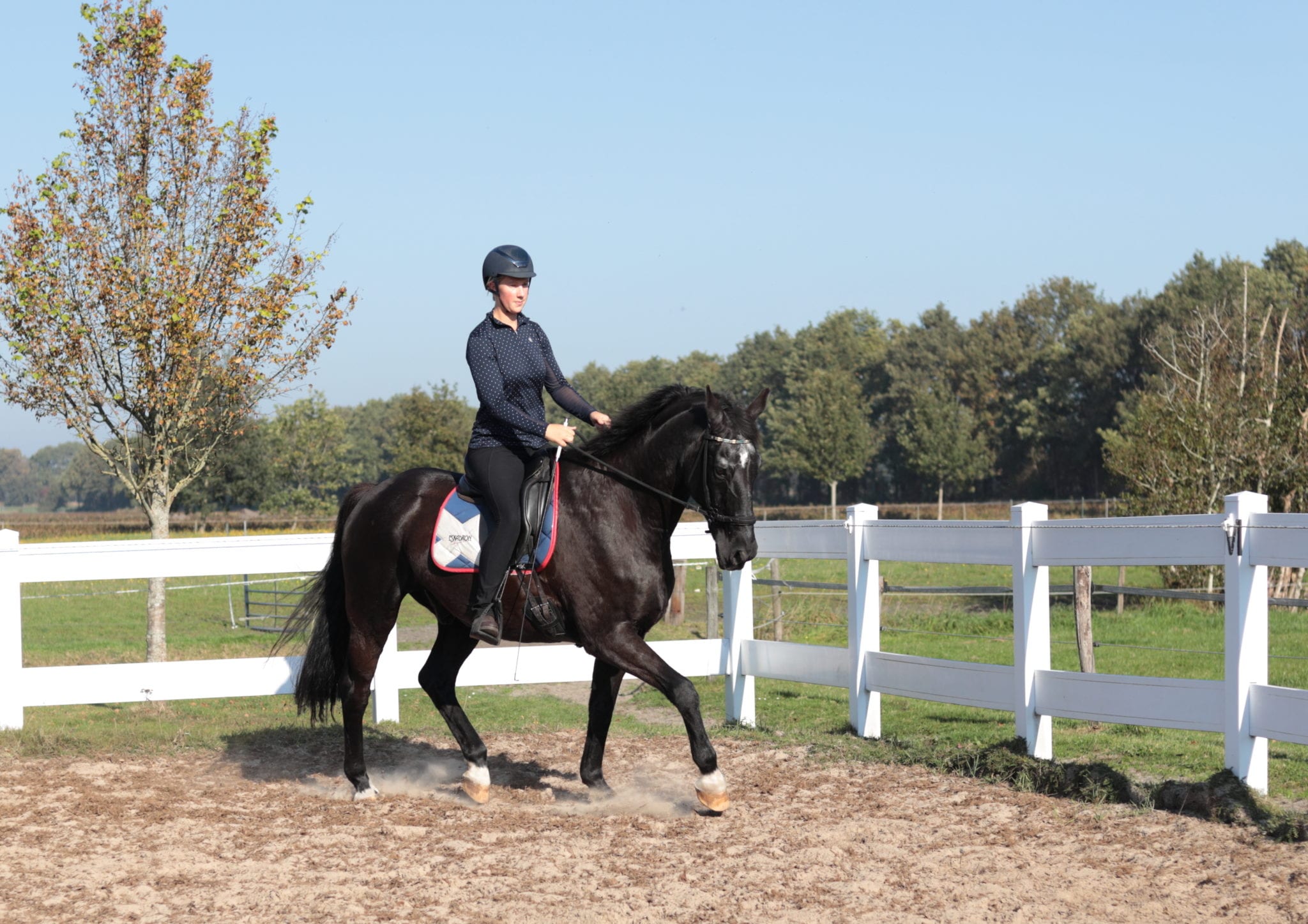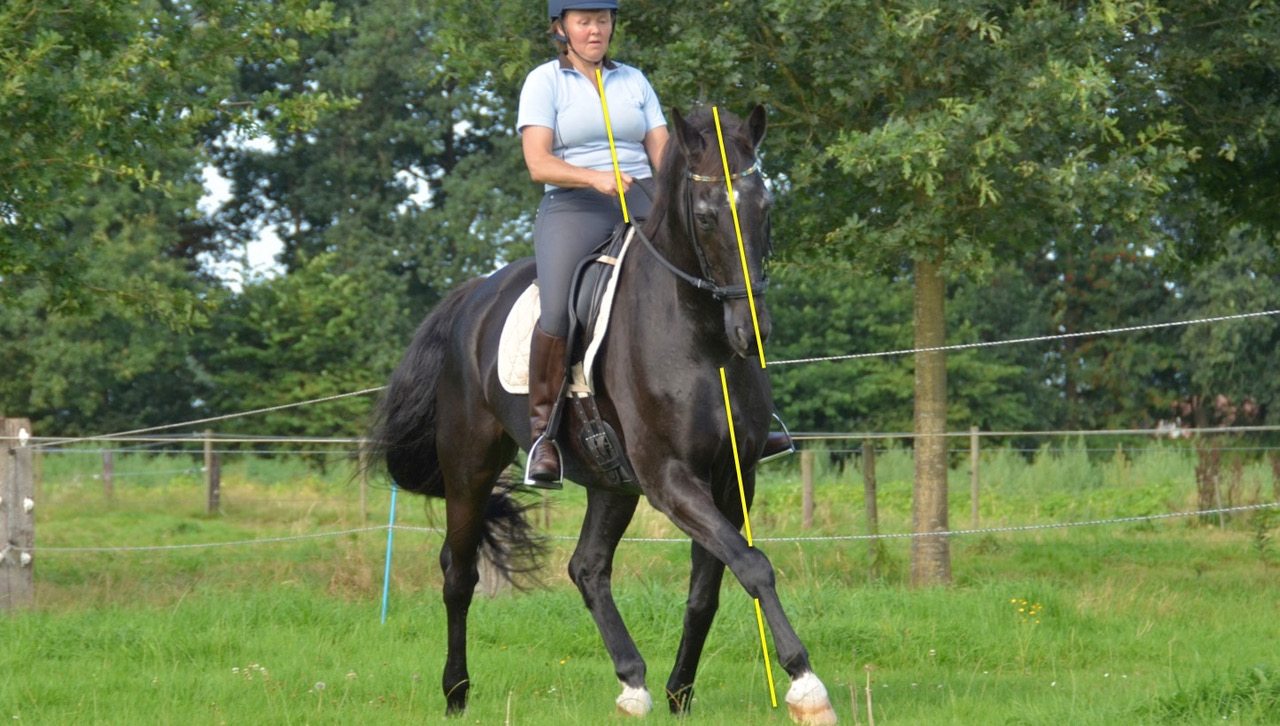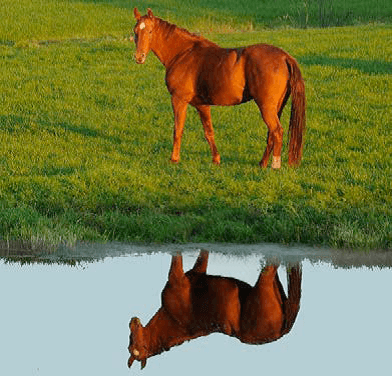english content
Comicstory: Bresila-Jane learning Jambette









Want to learn to play with your horses too?
Or join one of these courses:
- 3-daagse clinic Excellent Horsemanship 10-12 april 2022 Helvoirt (Brabant)
- 5 Day Intensive trainingsweken (in the Netherlands or at request on location)
- Online cursus “The 9 Habits of Excellent Horsemanship” (English, a Dressage Naturally course by Karen Rohlf, highly recommended!)
About motivation: how much credit do you have on the Relationship Account with your horse?
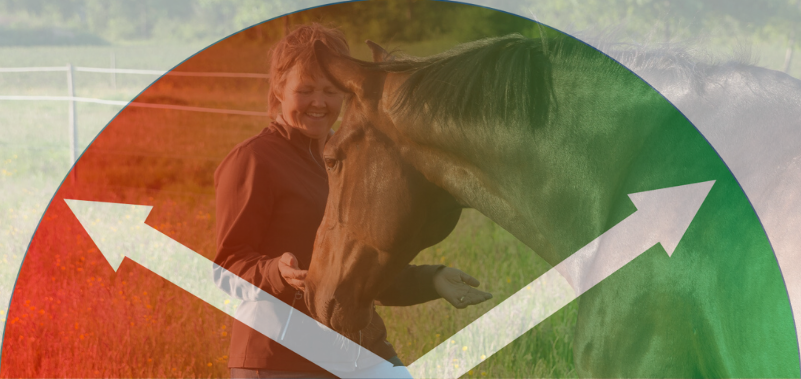
Lees je dit liever in het Nederlands? Kijk dan HIER
There's nothing wrong about a bit of ambition ... as long as your horse WANTS to join your game
I would love to do all kinds of fun stuff with my horses. I would love to ride them. I would like them to develop healthy biomechanics. I would like to ride dressage, to jump, to play at liberty, to go on the trails and more. Above all I want to have a great time together with my horses.
How my horses feel about it matters!
How my horses feel about me also matters to me ... a lot! With everything we do I like to keep in mind that they did not ask for all of this. They have no idea whatsoever about my wishes and ambitions. They do not have a choice. They do not value prizes in competition, share my ambitions or understand the imaginary importance of 'keeping up appearances'. They owe me nothing!
How much credit does my horse give me?
Both me and my horses do not like to be forced into something. Still I am sometimes a bit intense or persistent when trying to teach them something new, to improve their physical fitness or to change their biomechanical patterns. It would make me sad though, if my horse would not want to be with me anymore after such an occasion. I always strive to have enough credit on our relationship account to allow some room for asking the extra effort, either mental or physical.
I never want to get below zero, in the red zone. So I need to make deposits into the relationship account on a regular basis. In other words: we do things that my horses really like. So often and so much that he clearly stays interested in being with me and in the things we do together, even when I ask a bit more effort sometimes.
If it was about money ... how much can you afford?
Do you consider the state of your bank account before you buy something?
If you saved a bit you have something extra to spend. On the other hand: How does if feel if your account is negative and you have nothing left to spend? Does it cause stress or frustration? Does it keep you from your sleep when you are in debt?
I think we all agree that it's smart to economise before your account hits zero, and that it feels good to save something extra to play around with.
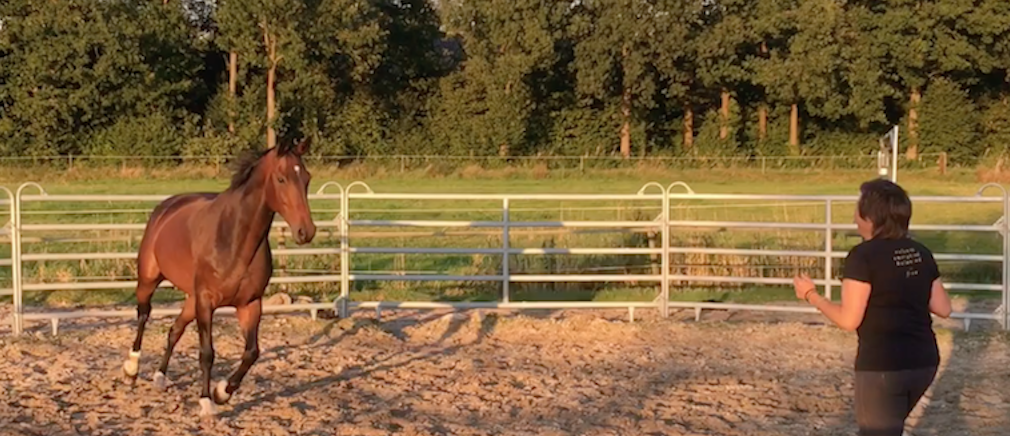
Your horse will tell you about the balance of your Relationship Account
Signs of plenty credit (green)
Your horse is curious and happy to apply effort. He shows a lot of try, is mentally engaged, offers initiative and sometimes offers even before you ask. He follows you freely and comes to meet you in the pasture.
Signs of increasing credit (light green)
Your horse is attentive, relaxed, responsive, greets you with a soft voice and does not walk away when you approach him in the pasture.
Signs of decreasing credit (light red)
Your horse shows lack of effort and interest, is slow in his responses or shows signs of tension or anxiety. He does not (try to) understand, is not relaxed or interested enough to think or reacts instinctive on your aids (with flight, fight or freeze). You have to work hard to get him to do what you want.
Signs of being indepted to your horse (red)
Repeated refusal, anger or fear. He gives up, is afraid to make mistakes or is in a state of learned helplessness. He turns away from you when you approach him and wants to avoid being saddled or groomed. Even when this behaviour is caused by somebody else, it can be you who has inherited the depts!
Making deposits into the Relationship Account on a regular basis
Everybody with horses will be confronted with all of the signals above in some way at some moment. Good and bad, small or substantial, occasional or structural. Sometimes it is a moment in time but if a certain behaviour shows up more often it becomes a tendency or even structural pattern. So we need to be aware in the Here and Now, because the balance of your Relationship Account is dynamic. It changes all the time when you are together with your horse. In the long run we want to develop lots of credit and stay in the green zone as far a possible. Every session with your horse should ideally add to the balance. On that day and for the longer term, increasing the bond with your horse over time.
What can you do?
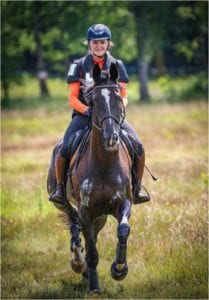
-
- Know your horse! Know what makes him happy. Grazing, treats, voice rewards, scratches, resting, running, playing, touching, chewing on something, standing on something or simply doing nothing together. Not every horse likes the same things and it can change with the situation. Lots of horses do not really like to be petted on their face. Stressed horses usually do not value treats a lot and centainly cannot keep their feet still to rest. Slow horses on the other end probably love to stand still and rest, while playful horses like to jump and play!
-
- Find a fair balance between your own ambitions and what is really important to you horse. If you want to make fast progress in educating or training your horse and you ask your horse to intensify his effort you can expect loosing credits with him. If you do not compensate this by doing something for the horse you can expect your progress to slow down or even get stuck. So every day do something for your horse too. You never want to get in the red zone!
-
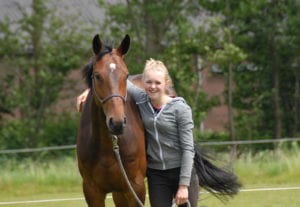 This is personal. Horses know who is who. This is about the personal relationship account between you and your horse. His relationship with you is not the same as with your co-rider, groom, sister or anybody else. Just like the relationships between people. For one person you'll do just about anything to please or help, while for the other you would not feel inclined to put in any effort. If you lose credits with your horse you cannot ask somebody else to compensate for this. If you want a lot of effort from your horse, you have to restore the balance on the relationship account!
This is personal. Horses know who is who. This is about the personal relationship account between you and your horse. His relationship with you is not the same as with your co-rider, groom, sister or anybody else. Just like the relationships between people. For one person you'll do just about anything to please or help, while for the other you would not feel inclined to put in any effort. If you lose credits with your horse you cannot ask somebody else to compensate for this. If you want a lot of effort from your horse, you have to restore the balance on the relationship account!
-
- Use variations in training wisely! The cliché that variation in training keeps your horse motivated is only true when this variation is really valued by the horse itself! By example: on one day a concentrated dressage training and on the next day you make a walk with a lot of grazing moments. A variation like: one day dressage and the next day 1 hour of senseless and lonely circles in the walker, does nothing for your horse and thus nothing for your relationship. In other words: find things you can do together that he really likes.
- Play with the relationship account on different time scales. You don't want to take, take, take for a long time until you are deep in the red zone and only then start thinking about how to repair your horse's trust and motivation. The more often you find yourself indepted to your horse the harder it will become to restore the relationship. So think about it on a smaller time scale. You can take on one day and give on the other. Or you can mix and match giving and taking within one trainingsession by altnernating between hard work and easy exercises or fun play moments. It is even better when you can balance give and take continuously by using lots of rewards at any moment your horse puts in a bit of effort. Big rewards like cookies or rest and micro rewards like a quick scratch or a happy voice. I can promise you that's a habit that will make you both feel happy!
Do you want to learn more about how to put this into practice?
Or find out about the possibilities of online study or personal support:
- The Dressage Naturally Virtual Arena
- 1 on 1 Videocoaching
- Online cursus "The 9 Habits of Excellent Horsemanship"
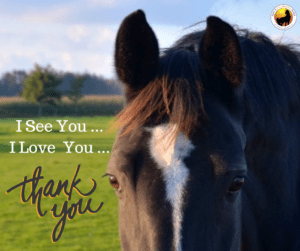
3 weeks with Liesbeth Jorna - All about doing less and getting more
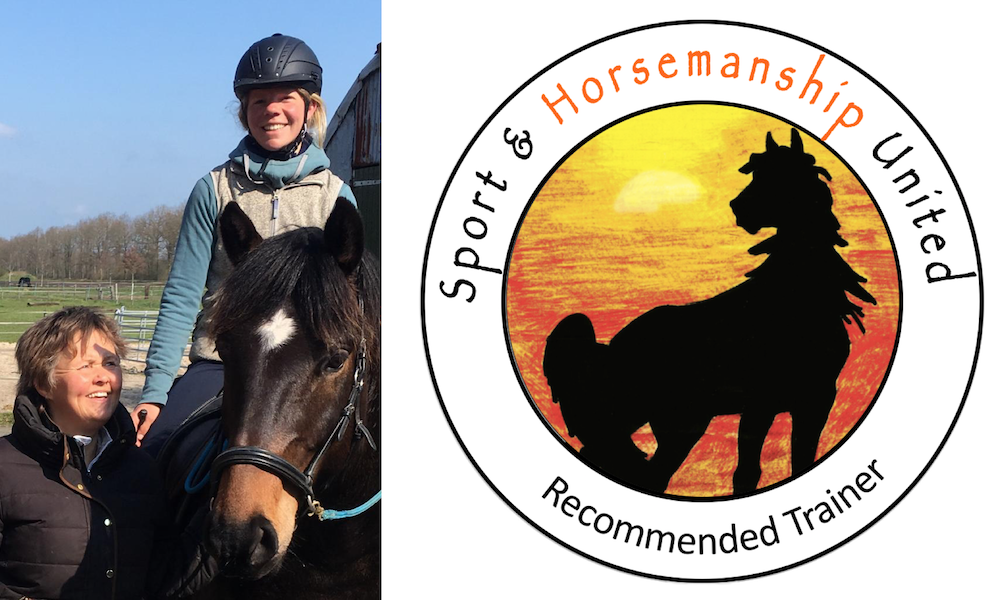
by Fenja Täuber, Recommended Trainer Sport & Horsemanship United, May 2019 (www.pferde-leicht.de)
A clear starting point
Liesbeth welcomed me and my two horses Conrad & Charlie for three weeks at her place in the Netherlands. Right at the beginning, Liesbeth and I defined my goals for the stay. I wished to improve my riding skills with Conrad, especially in stepping up to more collection. Furthermore, I was hoping to gain more confidence with my 5-year-old Charlie towards riding him. We started with a checkup session with both of my horses online (= on a line) to get an impression where we are at.
Searching for a “next level” Sweet Spot of Healthy Biomechanics
In these first lessons, I learned how to bring them in a real Sweet Spot on a circle. They were both stretching but aligned on a straight line while walking on circle. So Liesbeth taught me how to really see the difference.
Understanding where the Sweet Spot on the circle really is made it easy for me to support them to sustain it. And furthermore, learning how to change the alignment while travelling without disturbing their forward movement was very important to me. Liesbeth gave me an idea of how little I have to do to change their movement when I really go in an active neutral state in between.
My horses gave me the best feedback because they started moving way more free, supple, energetic and engaged. In a short time (2-3 days) their way of moving really improved. Wow! I was impressed and it made me realize that everything needed was already underneath the surface.
I was blown away by the number of things I already learned about myself and my horses in the first two days and was curious about the progress in my remaining time with Liesbeth.
Learning smart exercises to improve Conrad’s alignment
We focused on finding the Sweet Spot and a straight horse during the first ride with Conrad.
I figured out that my horse should be wanting to maintain the SS by himself. I thought I would be doing this already but noticed that I always had helped him a little tiny bit.
Through exercises like Drunken Sailor, Little Serpentines, Best Symmetrical Me, Thinking of Hindlegs and Opposite Reins (give the rein the horse takes and take the rein the horse gives) Liesbeth showed me different ways to find this alignment without compensation.
In a few lessons I was able to find it quicker and quicker. The key was to be very precise about what I want without micromanaging. So it was time to go on.
The training “Menu”
Liesbeth introduced a really nice image for a training session to me.Take it like a menu with a lot of different dishes and ingredients. There is a main dish - the part you really like to work on - and a starter and dessert to prepare and finish it up with. You can have several main dishes in one session and in between you give your horse a break. For example: relaxed walk or just standing still, a fast run for fun, getting off, some jumps or something silly he likes to do.
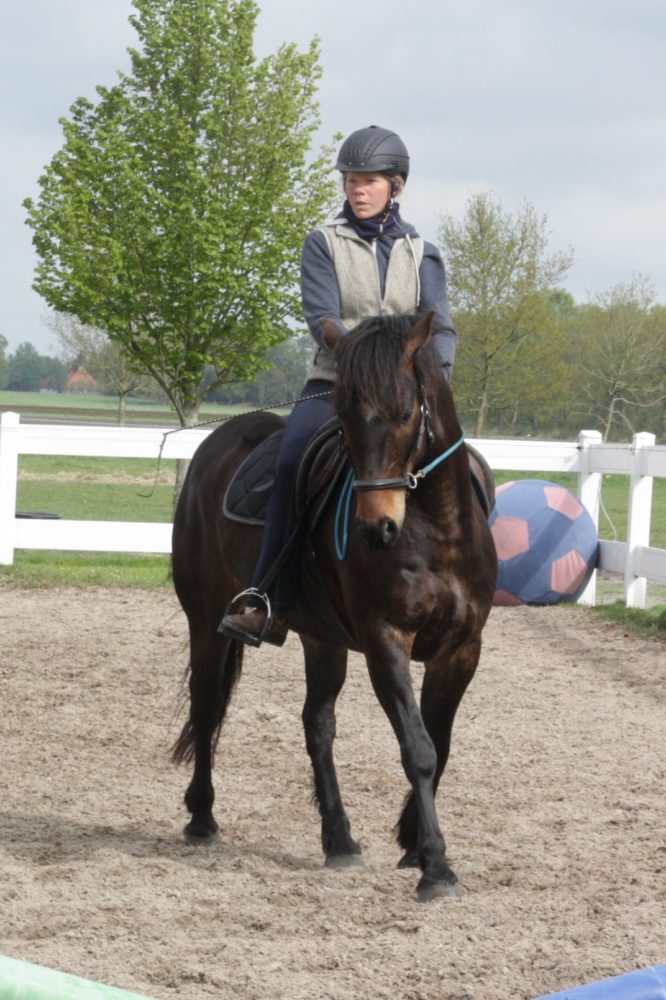
An independent Trainer’s Mindset and choosing my own patterns
To be able to make progress it is important to have a plan for each day. Well, your plan can always change because of different circumstances but if you focus on your goals then you can go on very fast. I like that Liesbeth was pushing me to my edges. Next to guiding me within my lessons, she supported me in sharpening my trainer mindset.Meaning that I took main responsibility in deciding the goal for each day and training.In that way, I can continue with that mindset in my own training at home by myself, without anyone guiding me all the time. I learned to think in patterns to create the main dish of the menu and got a lot of ideas for exercises from Liesbeth to invent more patterns. So that in the future I will be able to make wise choices for my training plans. „When you choose the right pattern, the pattern will do the work for you“.
You can choose different patterns that will all help to improve one topic. For example, for Conrad is was all about collection. Within the short breaks between the patterns you have the possibility as well to reflect on the last round and to look into improving the upcoming one. And very important, choose to finish at the best try of the day. I needed to remind myself to make smart decisions.
Riding Charlie appeared much easier then expected!
Finishing at the best try makes my horse put even more effort in the upcoming day and helps him stay motivated and myself as well. It´s worth it. This was also a very important point for riding my young horse Charlie. Together with Liesbeth we were able to make huge steps forward. Listening carefully to what he really needed gave him enough space and time to progress and grow. We could become confident with each step together.
The Dream Aids
In the first riding lesson with Charlie, Liesbeth started to explain how she would do the first steps. At that moment I was thinking: “I know what to do, I have been starting so many young horses.“ My ego came in my way and the moment I noticed this I got really sad and emotional. Liesbeth handled this situation great. She encouraged me and made me see that I already had been doing a lovely preparation with him so far. She told me Charlie is like a white sheet of paper. Right from the beginning, I am able to teach him my dream aids.
And this was so worth it to listen to! Three days later I was able to start cantering him just from intention and stop him by exhaling plus stop riding. Charlie was very relaxed from the start and able to do walk trot and canter on straight line and do a trail ride in the end. 
Thank you so much Liesbeth, that you opened my mind at this moment, by simply asking me about my dream aids and the phases afterwards.From now on I will always keep the following phases in my mind:(1) intention, (2)seat, (3) slight leg, (4) leg „Ping“, (5) voice or (6) stick. I had to be very precise and focused so my dream would come true. This reminded me again that everything with horses is about reflecting yourself.
Liesbeth told me that my basics are really really good and showed me how I can go on and build on them. She gave me a new feeling of how little I have to do to improve things and how important it is to know in each moment exactly what I want and to always praise the YES-Moments.
Positive training
I really appreciated that I could participate in all the lessons and courses Liesbeth gave these three weeks. I could gain lots of new ideas for myself and my teaching. While being an auditor I had the exercise to train my positive mindset. Meaning when you see somebody working with a horse, first ask yourself what you like about them. Second, think about adjectives you would also like the horse to have in his movement.
New theoretical insights
I loved all the theoretical background I got. For example: To get to know how to train the physical shape of the horse while staying in a positive training scale. I also got a real clear picture about lateral movement, how they work, what they can improve and how horse and rider have to move.
Finding the feel of exercises
Very important I find the active exercises without a horse. They help to understand an exercise better or to just find the right feel for a movement. That is something I want to involve in my own training. One picture is stuck to my mind: let the water keep flowing while it runs through a tunnel underneath you. That means don’t let you and your horse’s energy get stuck in an exercise, be able to flow freely through it.
An amazing experience
Liesbeth I am so happy that our trails crossed. Thank you so much for telling me, that I am on the right way. No Trainer before was able to give me such a clear feedback about my own skills. You helped me seeing more clearly where my strengths are and what I still need to focus on to improve. I have seen you helping so many different riders and horses to become a better team. You are able to not just give them a concept about what to do but also bringing their biggest challenges to the surface and helping them through it. For me it is very valuable to have somebody on my side with a lot of horse knowledge, a long term teaching experience, a very powerful didactic, an open mind, really being authentic, living with positive vibes, and having so much fun while you do what you like.
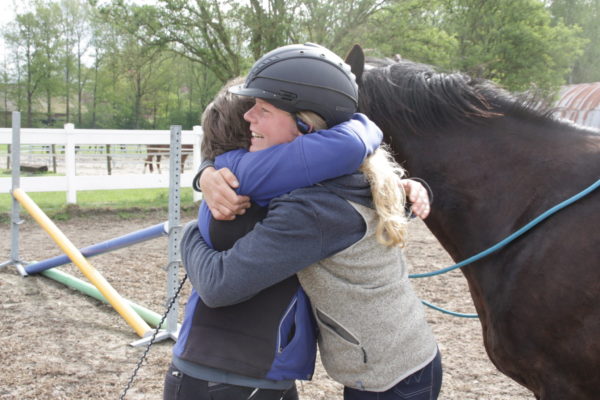
You brought me a huge step further and I would always do this intensive training again.
When telling me that you will recommend me as a trainer, I felt so honored and would have never expected this. Liesbeth, thank you so much for this support.
Learning is a lifelong journey and I want you to be part of mine!
Fenja
------------------
From Liesbeth:
It was a total joy to share 3 weeks with you Fenja and thank you so much for your beautiful words! You proved to be such a skillful horsewomen and rider and your horses clearly love you. It was amazing to see how quickly you and your horses developed in this short time. I credit this to your positive mindset, the high level of communication and wonderful relation with Conrad and Charlie that you already had to start with, and of course to your Dressage Naturally studies. You are very welcome to come again and then we'll start where we left of: with zig-zag halfpasses and flying leadchanges :o)
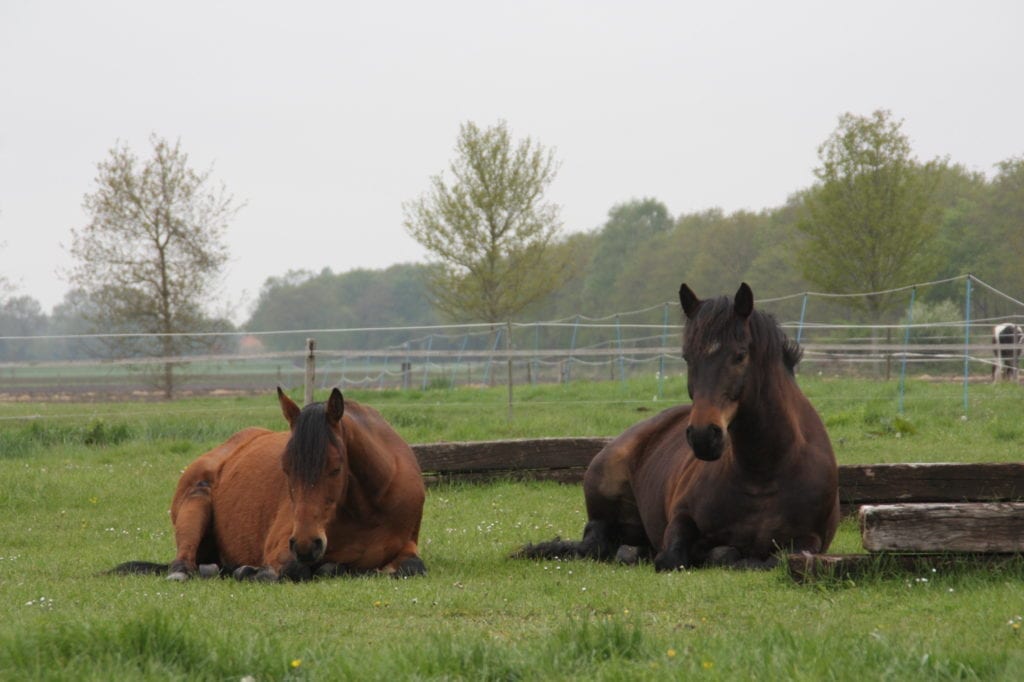
P.S. Does this sound like something you would want to do too?
Are you an ambitious learner, trainer, rider or educator and do you want to boost your knowledge and skills in (sort of) the same way as Fenja did? Study with me for a few weeks and bring you own horse? I do this only very occasionally and only with highly motivated students, but if you really want this, then let me know!
6 Tips for more Freedom of Movement under saddle
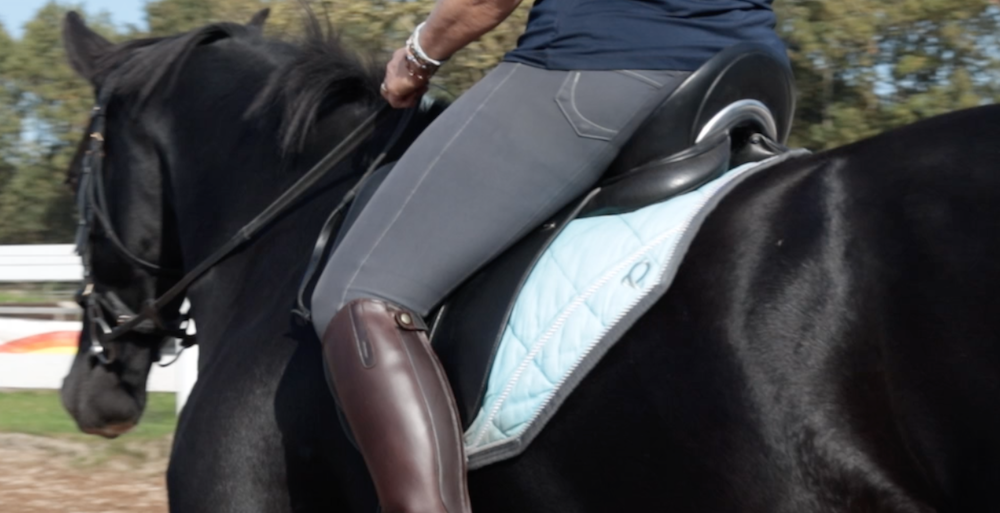
Freedom of movement, without constraints or compensations, is the most important factor to guarantee a life free of injuries for your riding horse, but … it’s also the easiest thing to destroy, even without meaning to. Here are some tips to improve your horse’s freedom of movement under saddle by making changes to your own biomechanics.
2 Tips for the walk
If you want your horse to walk freely and almost not notice you, you’ll probably need to move more than you would expect. A static seat and posture actually gets in your horse’s way!
Relax your pelvis and thighs and make sure your calves softly stay in touch with his belly all the time. Allow your legs to be moved by the horse while keeping your seat and upper body stabilised. You’ll feel his barrel roll to the left and to the right, lifting your legs up and out one by one. In this way your legs stay silently in one place for the horse in stead of dangling around.
Relax your shoulders, elbows and wrists. The neck of your horse shortens and extends with every step. Allow this movement of the horse to take your lower arm forward and then allow your elbow to fall back in place every step. Your shoulder- and elbowjoint will move with every step, while your wrists and hands stay soft. By allowing your horse to move your arm in accordance with his head- and neck movement, your hands will feel soft for the horse and the rein pressure will stay the same throughout the movement.
2 Tips for the sitting trot
Sitting trot is quite a challenge for many riders. More than often it leads to holding your breath, bracing against the movement or bumping uncomfortably in the saddle. This leads to lack of clarity in your aids, whether that be the aids with your breathing, your seat or your legs. Let alone the reins! Your horse will answer with tension and bracing his back, thus losing his freedom of movement. So what can you do to “get out of his way”?
To begin with, te best moment to start sitting trot, is when your horse already can be calm, rhythmic and relaxed through his back. If he is still very crooked or on the forehand your chances for a comfortable sitting trot are not very high. So first focus on finding a ‘sweet spot’ while still riding a rising trot. You can test how sitting trot feels but if it feels awkward or when your horse braces the instant you try, go to rising trot again.
Sitting trot takes fitness of the rider too. You’ll need some core stability and coordination too, so start simple and build up gradually. Start with only 2 steps, then rising trot again, then 3 steps, 4, 5 …. al the way up to 20. If you get stuck after - for example - 8 steps, then repeat these 8 steps untill it feels better. Only then go for more. In the meantime, while playing this game, you can experiment with small adljustments in your posture or breathing to find your “sweet spot” for sitting the trot.
2 Tips for the canter
The most important thing is not getting in the way of the upward movement towards the moment of suspension, when all 4 feet of your horse are in the air. If you lean back on your tailbone or push into the saddle you’ll block this upward motion, causing the strides to get choppier and shorter and less expressive. So rise up with the horse. Envision you have velcro under your pants, pulling your horse’s back upwards with you every stride.
Adjust your breathing to the rhythm of your horse. Your horse breathes in when rising up towards the moment of suspension and breathes out when moving downward. When you can synchronise with this for a while you’ll feel your horse’s cadence improve! This takes some exercise because this goes fast and we do not want you to hyperventilate! So another easier way is by example to breath in for two strides and breathe out for 2 strides. This already can change the way your horse canters.
Let’s find harmony in motion!
L*
Don't get stuck in a "system"!
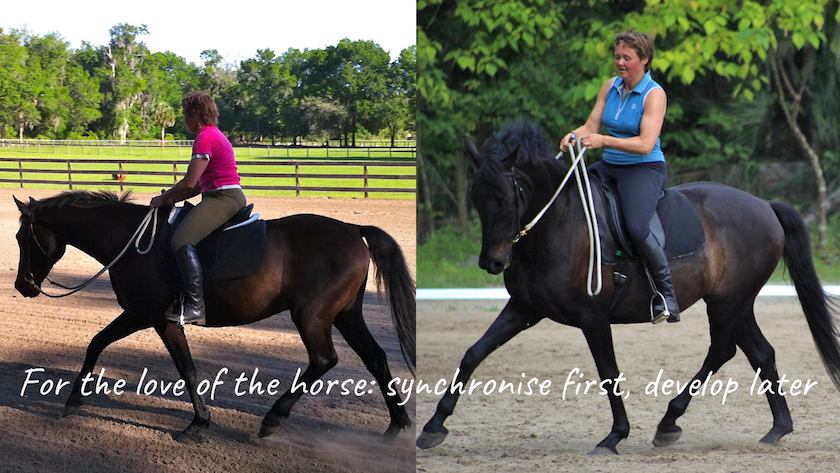
Why riding naturally is important to your horse
Recently I met a horse and rider who had been struggling to find a decent canter for more than one and a half year. The rider told me her horse went hollow backed, ran too fast and for the rider the canter felt most uncomfortable and even a bit unnerving. She was desperate to find a solution.
I watched them play online (on-a-line) first and then the mare’s canter appeared very nice. A good cadenced stride, a lovely canter really on both sides. Even such a nice canter that I could easily envision her in a cross country or dressage test. So I wondered what was causing the problem when ridden.
Stuck into a system. "I cannot move this way!"
In the riding session that followed later that day the root of the problem soon showed itself: rider and horse had gotten stuck in “a system”, literally.
The “system” that was taught by her instructors had not put the needs of the horse first, but the system itself. In stead of building a system around the nature of this horse they had - without realising this - tried to mould the horse to the system. Techniques from the system had been used without being aware or taking notice of the needs of the horse, even though she gave very clear feed back through her body language. Looking at the mare, even before we touched the canter, I felt she told us in many ways “I cannot move this way!”. She seemed pretty desperate and although her lovely rider noticed this she had no idea how to help her other than using “the techniques” of “the system” she had been taught even more.
Freedom to move naturally
In this case the horse was constantly asked to carry the head and neck high and she clearly could not move comfortably that way. She had no freedom to use her neck freely and that blocked her shoulders, back and hindquarters. Her body getting stuck and unbalanced also caused her to feel helpless and stressed. So this way of riding not only affected her body but also her mind and emotions.
In fact, there was a quick an easy way out of this situation! First I brought the riders awareness to what her horse was trying to communicate and she immediately understood. She lowered her hands to a neutral position and immediately her horse thankfully lowered and lengthened her neck. The movement that showed up was as nice as she had been without the rider!
When we came to the first canter the rider was asked to create a light seat and put her hand far forward on the neck of the horse. In this way she did not get in the way of her horse’s natural canter. Even though in the first moments this was quite exiting it was clear that the mare very soon relaxed into a beautiful canter. The next days she showed up a different horse: relaxed, soft, very supple and willing, balanced and round. It was an amazing change and it was a huge relief for both horse and rider!
Synchronise first, develop later
What is the take away is from this story? The horse should define the path of the training, not the other way around. Listening to the horse and starting from what nature offers is the key!
This case made it again very clear how important it is to start from a free forward natural movement of the horse itself. Don’t try to put a horse in the strait-jacket of a system but feel and observe for what your horse has to say. The foundation should always be a biomechanic in which the horse feels comfortable, relaxed and free. We - as riders - need to synchronise with that natural movement first. And only when we find harmony together we can start to develop or adjust the horse’s biomechanics in such a way that he can carry us in a healthy way or even will be able to perform on a high level without getting stressed or injured.
Ride naturally!
L*
Do you want to stay updated on new articles and the teachingprograms of Sport & Horsemanship United and receive the english ebook of Cocoa's Journey? GO HERE
NL: Wil je op de hoogte blijven van nieuwe artikelen en het lesprogramma van Sport & Horsemanship United? KLIK HIER
Crooked?
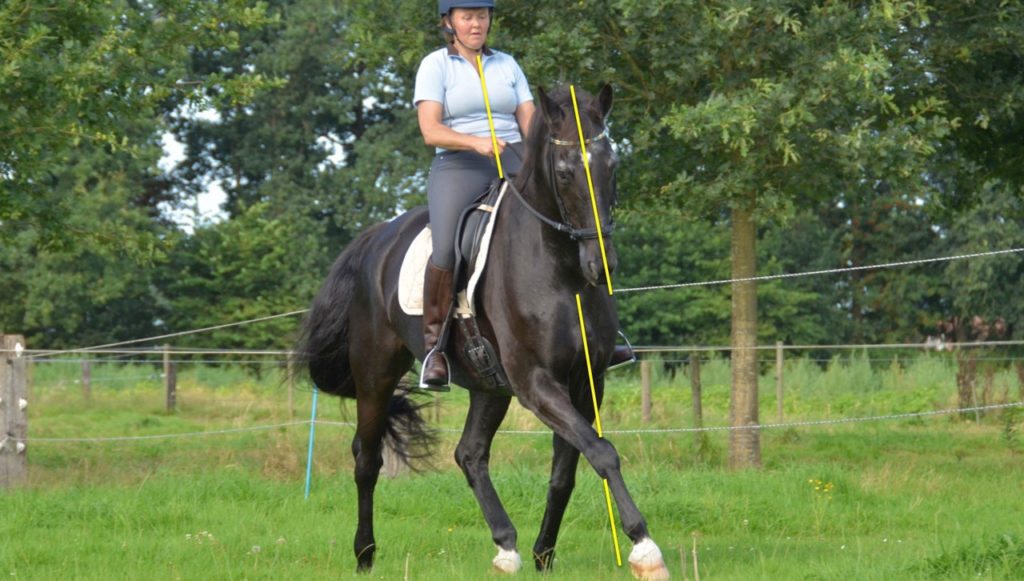
Is your horse leaning in or drifting to the outside?
What not to do:
Do not keep "correcting" it or compensate by leaning the other way!
Do not try to hold the balance. The more you hold it the more your horse loses it.
What to do:
Get curious! Explore the range of motion for leaning the opposite way. I mean ... really! ... overshoot target if necessary ... you should feel the weightshift!
Do not be afraid to mess things up! You should encourage you horse to really shift his balance. Even if just for a few steps. Immediately relax and reward for this try!
You want him to discover that he can and that there is a place that feels better. Of course he will swing back at first into his usual unbalanced place, but that's a good thing, for in the process he wil pass through a moment of balance. The more often he discovers that balance feels good, the easier it will be to find this place of balance... a place somewhere in the middle of leaning in and drifting out!
Develop self-carriage
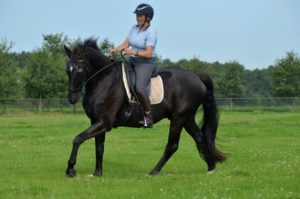 Allow your horse to enjoy the balance and keep it by himself. Then you’ll find he can keep it longer and longer. THAT is “self-carriage”!
Allow your horse to enjoy the balance and keep it by himself. Then you’ll find he can keep it longer and longer. THAT is “self-carriage”!
Get Creative... think backwards!
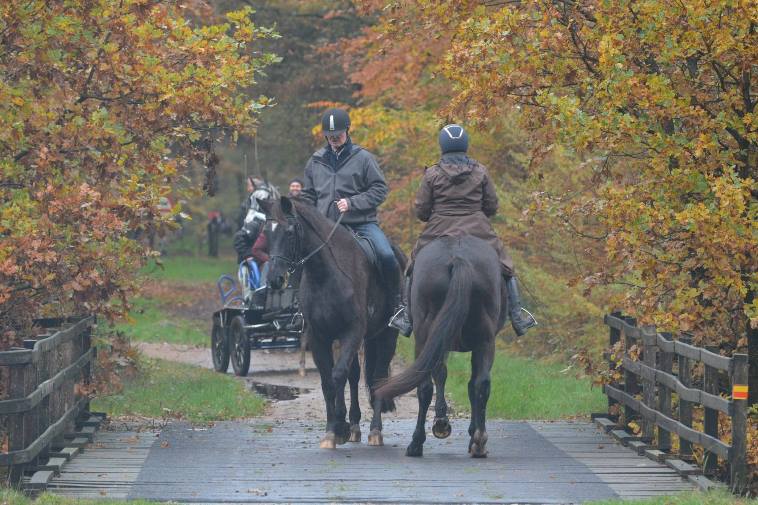
Many times I am so happy with my older horses!
During a group ride a few weeks ago we could not come across the bridge because Matador (left in the picture, with my husband in the saddle) rang the alarmbells so clearly that even Ivo (27, my super experienced ex-competition and parelli levels horse) did not move forward anymore. But thanks to his wisdom and education, his backwards worked wonders.
And yes, you need to be willing to do anything for a charming photo!
So remember this:
"Always start with the end in mind!"
Balance in the saddle
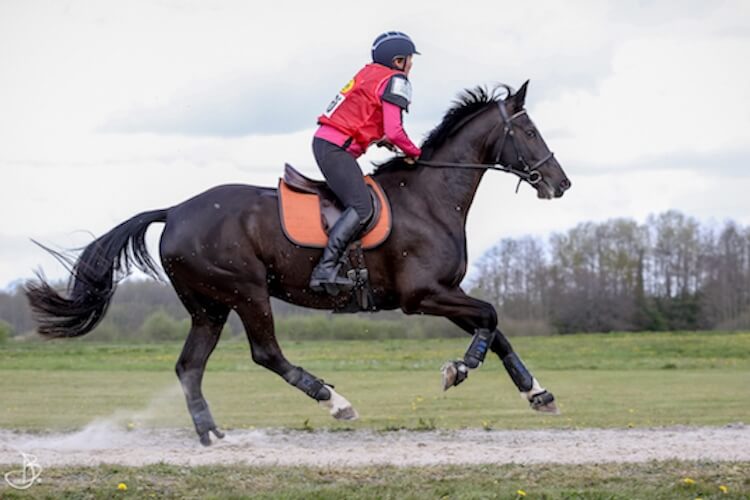
I often have students that have trouble keeping their balance in the saddle. They fall behind or fall forward, which causes them to loose their confidence as a rider. It feels uncomfortable for the horse too and can even lead to injuries due to compensation in their body.
What causes the unbalance?
- your saddle is unbalanced or your stirrupleathers hang to much forward
- the rider's position needs to be improved
- the riders's core stability is well enough developed
- the tempo and rhythm of the horse varies too much
... and there are lots of other reasons.
The saddle and rider's position
Of course the first thing to check is that your saddle not only fits your horse but also helps you find a balanced position. I see many saddles that either tilt the rider's pelvis too much forward or too much backward. Then the rider will have to compensate for the unbalanced saddle in their seat and bodyposition and will not be able to use refined aids. Also the horse will have to compensate in his body to stay balanced so he loses freedom of movement.
Tempo and rhythm of the horse
The more consistent the tempo and rhythm the easier it will be to stay balanced and the easier it will be to do the exercise described below. Later, when you can easily follow the horse's movement in an easy steady rhythm, you can challenge yourself to stay balanced through changes of rhythm and tempo.
A fun exercise to improve your balance and core stability
Start with a well balanced saddle! Then go and build your own balance through these steps:
- Let your horse stand still and stand straight up in your stirrups for a while.
Pay attention to this: keep breathing, rise up high from your core and let your shoulders stay down, heels pointing in the direction of your horse's tail, weight on your stirrups, opening the anlge between your pelvis and thighs.
And when you sit down again, make sure that your lower leg does not change position so you don't fall back into your saddle that last little inch. - Do the same in the walk, keep standing up for a few strides.
Additional points of attention: bring your pelvis forward when you stand up. Also sit back before you fall back so you don't hurt your horse's back. Simply try again while making the adjustments in you body as mentioned under 1 untill you can stay balanced. You should be able to maintain this position with your arm spread out for at least 10 steps.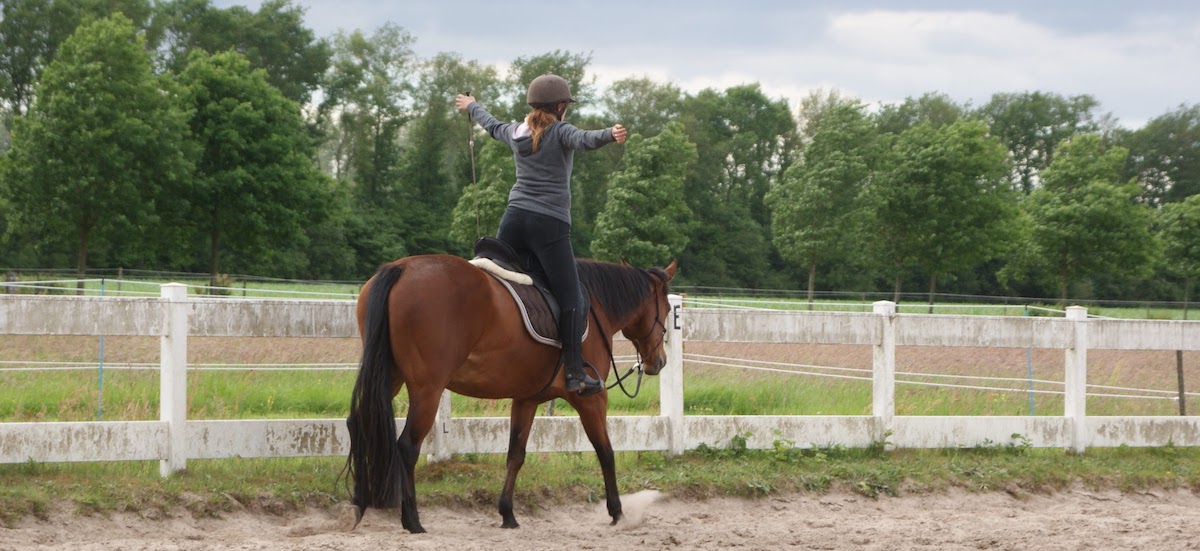
- This is the FUN part! Now you start counting strides: 1 stride up, 1 stride down, 2-2, 3-3 etc. until you can stand up 10 strides ... and then you count back down: 10-10, 9-9, 8-8 etc untill 1 stride up and 1 stride down. Do this exercise untill you are totally in control of your balance.
- When you master the counting strides exercise in the walk you can step up the game. Do exercise 2 and 3 in the trot. Focus, count precisely!
- Are you good at it in the trot? Then do it in the canter. In the end you will be posting in the canter and that gives a great feeling of balance, rhythm and harmony!
This exercise really helps to improve your balance and your connection with your horse. I do this exercise regularly myself!
Balance feels good and a rider that is balanced himself does not block the horse's freedom of movement!
Happy Trails!
L*
P.S.
If you want to use this article or parts of the article please remember to mention the source like this: "source: Liesbeth Jorna - Sport & Horsemanship United (www.sporthorsemanshipunited)
Intention first
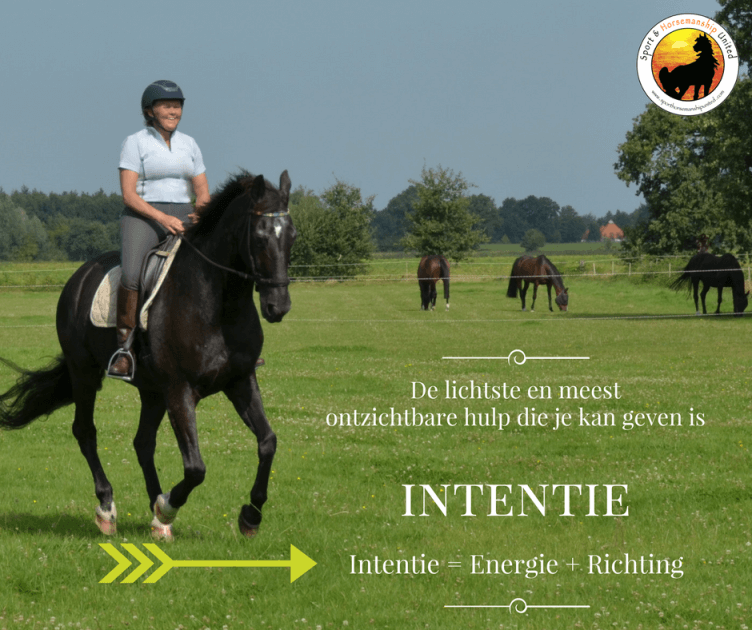
Intention First!
Do you want lightness in your riding?
Do you think that the further you develop in dressage or horsemanship, the lighter your aids and the more subtle your communication should become?
The lightest and most natural aid for your horse is your Intention.
To develop lightness and softness you can start with “radiating” your intention first, before you put on any physical aids or tools.
What is Intention?
Intention starts with having a clear mental picture of what you want your horse to do. Then you can transform that picture into Energy being sent in a specific Direction, to make it happen.
In short: Intention = Energy + Direction (I = E + D)
This Energy comes from your core and from your heart and should be based on that clear picture of the movement you would like your horse to make.
The Direction is where you want your horse to go. It comes with Focus and the Position of your body.
Energy and movement
Energy is not the same as movement.
You can radiate very high energy almost without moving, by example when sending your horse backwards away from you. A sharp eye and/or a lifting of your chest may already be enough.
The opposite - radiating total softness while moving a lot - is a very helpful skill when training unconfident or sensitive horses.
Energy can also go in both directions: you can send it away from you or draw it towards you. How we can use our energy to send a horse forward or away is very common, but you can even invite your horse to run to you by energetically drawing your horse towards you.
Horses read intention by nature
Remember that horses by nature read your intention in very much detail! As prey animals and herd animals their lives depend on this. Sometimes just a slight turning of your body or a minimal shift in your focus or even in your mind can make all the difference for your horse. I notice that a picture or thought that comes to mind, and which translates into an intention, often gives enough clarity without him feeling forced.
On the other hand … they read the lack of intention just as well! No intention means: no relevant information. In that case most horses choose to do what makes them feel the most comfortable. This is good to know, because his intentions may sometimes not be exactly your idea ;o) but also notice how you can offer your horse moments of relaxation this way.
Switching on your “intention button”
If you want to use the power of intention but it does not come naturally (yet) the first step is to become aware that you have the choice to switch it on and off.
A little story to illustrate this …
I remember I went shopping with my daughter Mandy on a busy Saturday afternoon. She must have been around 10 or 11 years old then, quite thin and not very tall. There were lots of people in the shopping street and Mandy complained to me about people bumping into her all the time. We knew there was a bakery at the end of the street, a few hundred meters ahead of us. So I said to her: “Remember the bakery over there on the corner (where they sell that super icecream …)? Just point your eyes ever there as if you can already see it clearly and send your feet over there in a straight line as if nobody else was in the street. Don’t look at the people, look at the bakery.” She did exactly that: she pictured the bakery and where it was, she focused and stepped forward energetically but relaxed. We got to the ice cream without anyone bumping into her anymore!
A simple example when riding: From a halt at A I want my horse go to C in an active trot.
I picture the trot; how it feels, the tempo, the line of travel and how we arrive at C. You could say: “I picture the speed, direction and destination”.
Then I use my intention first to find the active trot (using my other aids if intention only was not enough) and I send that energy in the direction of C by focussing on C and turning my body towards C too.
Intention First!
So … using your intention first - before using physical actions and aids - can save you from pushing and pulling and using your tools a lot.
You CAN switch it on and off on purpose and the more you use it the more your horse will respond to it. He’ll start to notice when you have a clear intention and he’ll start to understand that everything you do with intention is meaningful.
I hope your intention helps you and your horse find the lightness you dream of!
L*
P.S.
There is a very effective exercise that teaches you how to develop a clear focus and intention AND that helps your horse get sensitized to your bodylanguage and more balanced on straight lines: "The Corner Game".
I made a special 2 part Video/Audiotraining about this. You can find it here: Videotraining "Riding Balanced Corners" At the price of only €27,50 it make a huge and permanent difference for horses and riders on every level.
MIZU NO KOKORO - a mind like water
Do you listen ... or do you wait to talk?
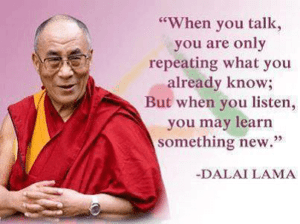 Usually as riders we tend to talk and "send" a lot. As trainers we request all sorts of specific responses and physical achievements of our horses. To safely ride on the trail, to create healthy biomechanics or maybe to satisfy our ambitions in competition. It is okay to expect a lot ... but when you want to be partners with dignity - you want your horse to play this game with you - you need to be willing to wait for, and listen to your horse. With an open mind, so you can see, hear, feel and learn freely. With a mind and a heart like water. "Mizu no kokoro", as they would say in the world of martial arts.
Usually as riders we tend to talk and "send" a lot. As trainers we request all sorts of specific responses and physical achievements of our horses. To safely ride on the trail, to create healthy biomechanics or maybe to satisfy our ambitions in competition. It is okay to expect a lot ... but when you want to be partners with dignity - you want your horse to play this game with you - you need to be willing to wait for, and listen to your horse. With an open mind, so you can see, hear, feel and learn freely. With a mind and a heart like water. "Mizu no kokoro", as they would say in the world of martial arts.
Mizu no kokoro - a mind like water
Still Water - True Vision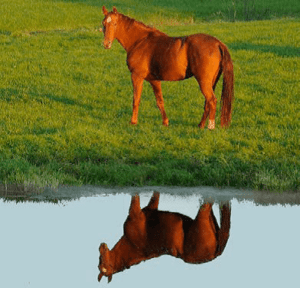
Imagine a pond where the water is calm and the surface perfectly still. No stirring by wind, rain or movement under the surface. The water gives you a perfectly clear reflection of it's surroundings, of what is really there. This is how we want our heart and mind to be when we are with horses: still, calm, relaxed, free of internal dialogue and judgement. We want to see, hear and feel our horse as he really is, undisturbed by assumptions or disturbance.
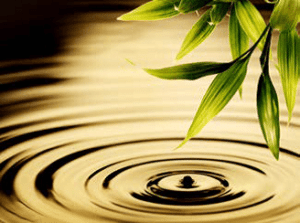 Ripples - blurred Vision
Ripples - blurred Vision
When disturbed, the water ripples. It reacts as much as it needs to… not more, not less. How we react to our horse should be in harmony with his actions. No over- or underreaction. The reaction in our heart and mind can be like water; an equal match to the situation.
Returning to Calmness
Soon after the disturbance the lake will return to its original calmness. This is a lesson to learn and apply to our life with horses as well. Too many times we forget to return to silence; we keep our aids on when the horse is already answering our request. Too often we keep looking in the rearview mirror at what happened in the past, and forget to think forward. Thus we keep making ripples in the water, and our reflection of what is really there will be blurred. After your reaction to a disturbance, or after your horse has answered to your aids, remember to return to the calm mind you would normally keep. Just as the surface of the lake becomes pristine once again.
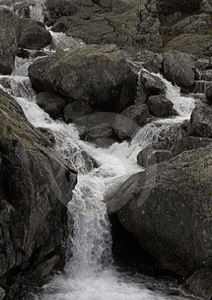 Adapt and flow
Adapt and flow
Water adapts to circumstances. It changes its flow or form as needed. With a mind like water you will not get trapped in dogma's or patterns from the past. You can adapt to what your horse offers. Accept it, harmonize with it, synchronize with the movement, join the flow and stay connected. If you fight it you will never really win. If you accept what is and stay connected, then you may change the way of the flow in another direction and find unexpected progress. It is the adaptable mind that will create the strongest partnerships.
Mindful horsemanship: calm, open, being in the here and now
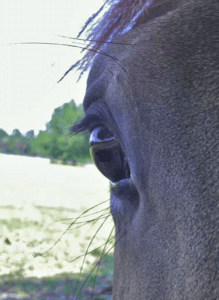 When your mind is like water, you are open minded, in the ‘here and now’. You are still, calm and at peace with yourself and your horse. You listen before you talk. You are connected, patient enough to follow, adaptable and active enough to lead. Making assumptions or judging what you see is like stirring a stick in the water. It makes ripples and blurs your feel and vision. With a mind like still water you will feel and see what is really there, without judging it, and start changes from there. Once you achieve this clarity of mind, you are then capable of something very special called insight: the ability to see, feel and understand your horse with a light heart. Then you can train together with wisdom and kindness.
When your mind is like water, you are open minded, in the ‘here and now’. You are still, calm and at peace with yourself and your horse. You listen before you talk. You are connected, patient enough to follow, adaptable and active enough to lead. Making assumptions or judging what you see is like stirring a stick in the water. It makes ripples and blurs your feel and vision. With a mind like still water you will feel and see what is really there, without judging it, and start changes from there. Once you achieve this clarity of mind, you are then capable of something very special called insight: the ability to see, feel and understand your horse with a light heart. Then you can train together with wisdom and kindness.

